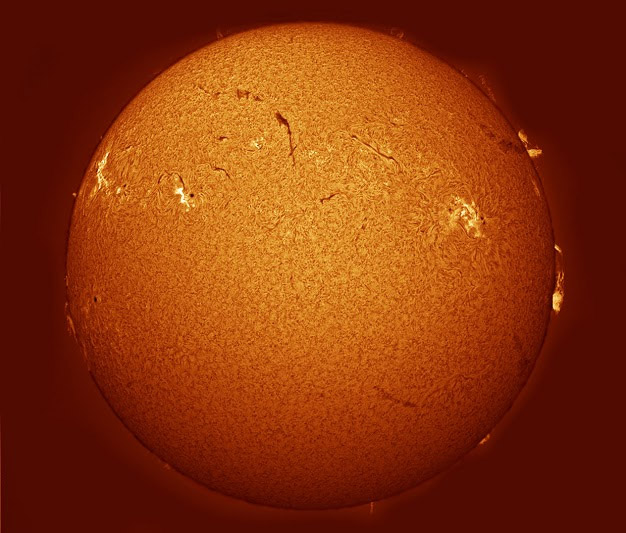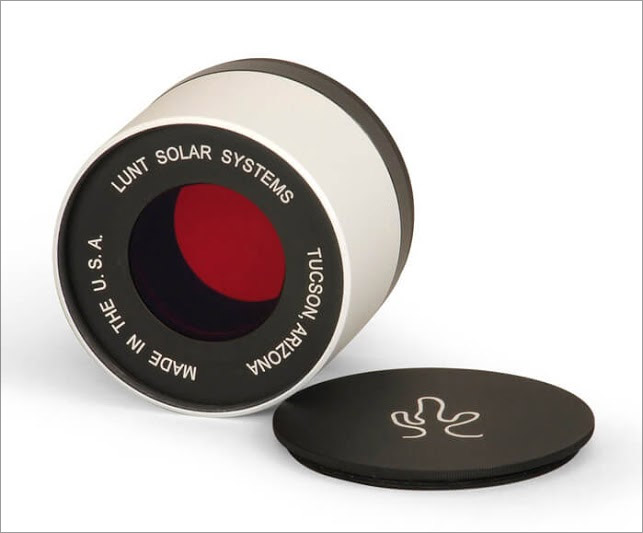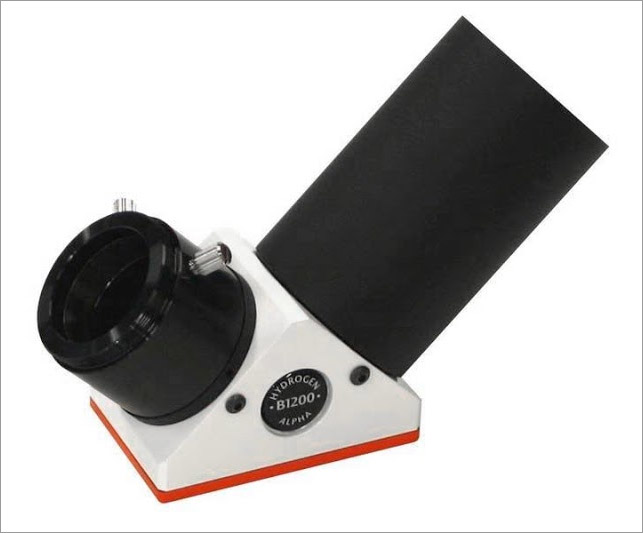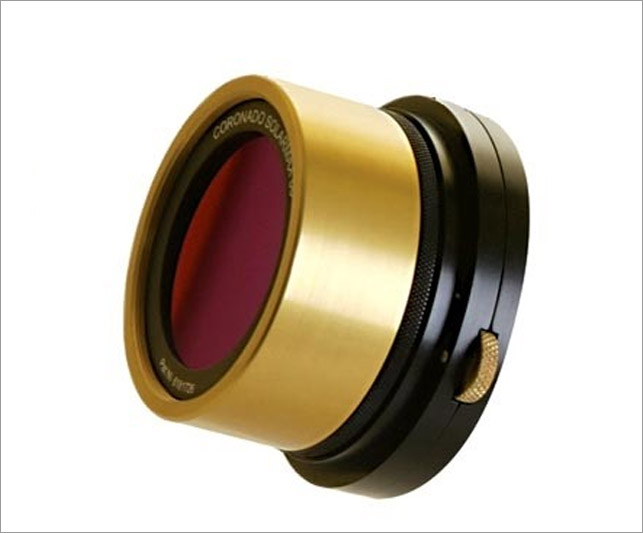A Guide to Hydrogen-Alpha Solar Filters and Telescopes
By: Brian Ventrudo and Manish PanjwaniDiscuss this article in the forums
July 15, 2016In this fifth article on solar observing, you learn about another kind of front-mounted solar filter for amateur astronomers, the so-called hydrogen-alpha filter. Unlike white-light solar filters, these optical devices are designed to pass only a narrow band of red-orange light while blocking all other wavelengths of the bright white light from the Sun. With a hydrogen-alpha filter, or a with dedicated hydrogen-alpha solar telescope by manufacturers such as Lunt or Coronado, you can see the dynamic and explosive events in the Sun's chromosphere such as prominences and filaments, solar flares and mass ejection events, and the bright plages in the chromosphere above sunspots. Such filters offer stunning views of the solar disk during periods of solar activity and during the transits of the inner planets and partial and total solar eclipses.5.1 Seeing Above the Sun's Photosphere
As you learned in a previous article, white-light solar filters let you see sunspots and many other intriguing features in the Sun's photosphere, the narrow layer of the Sun where infrared, visible, and ultraviolet light leave the Sun and travel freely into space. The bright white light from the photosphere far outshines the light coming from the chromosphere, the more rarefied layer of glowing hydrogen gas just above the photosphere. The chromosphere holds many fascinating and beautiful features that can be seen with a small telescope. But to see these dynamic features, you need a filter for your telescope that passes only the red-orange light from the glowing hydrogen atoms in the chromosphere while blocking the brighter white light, infrared light, and heat from the photosphere.
A hydrogen-alpha (H-alpha) solar filter is just such a device. The idea behind these filters is fairly simple. Hydrogen, like all gases, emits light at dozens of fixed wavelengths set by principles of atomic physics. When the lone electron of a hydrogen atom falls from its second to first excited state, it causes the emission of reddish-orange light at 656.3 nanometers to settle accounts. This is the hydrogen-alpha wavelength. A hydrogen-alpha filter passes light from the chromosphere in a narrow band around this wavelength while blocking the overwhelming white light that comes through the photosphere. This filtering effect lets you see only glowing hydrogen gas and gives you the contrast to see the Sun for what it really is: a dynamic, seething, and occasionally violent place where immense amounts of energy and hot gas are flung into space over the course of a few minutes or hours.
 Fig. 1: The Sun as imaged with a hydrogen-alpha solar filter. The image shows emission of light by hydrogen gas in the Sun's chromosphere at a wavelength of 656.3nm. Credit: Sergio Castillo.
Fig. 1: The Sun as imaged with a hydrogen-alpha solar filter. The image shows emission of light by hydrogen gas in the Sun's chromosphere at a wavelength of 656.3nm. Credit: Sergio Castillo.5.2 How a Hydrogen Alpha Solar Filter Works
First, a word of clarification and of safety. You may also come across another type of hydrogen-alpha filter for astronomy. Such hydrogen-alpha filters are used for visual observing and photography of emission nebulae in the night sky, nebulae like the Orion or Lagoon Nebulae. But these filters are NOT solar filters, so NEVER use them to observe the Sun. They do not provide sufficient protection and reduction of the Sun's brightness and they are NOT hydrogen alpha SOLAR filters. If you're not sure what kind of filter you have or need, ask before you buy or use.
A hydrogen-alpha solar filter comes in a set with three parts. The main filter is made of two mounted and highly reflective plates called an etalon. The two reflectors in the etalon cause light to bounce back and forth in the small space between them. When the light waves are the right wavelength to interfere constructively inside the etalon, they pass through. Otherwise, they do not. The etalon of an H-alpha solar filter is designed to pass light in a narrow band around 656.3 nm. By its nature, the filter will also pass light in multiples of this wavelength because such light will also interfere constructively in the filter. The spectrum passed by the etalon will resemble a "comb" of wavelengths, only one of which is the true H-alpha wavelength.
The unwanted light in the "comb" from the etalon is removed by a second component, a solar diagonal with an optical blocking filter. The diagonal takes the place in your telescope of an ordinary star diagonal used for night viewing. The solar diagonal passes only the narrow band of light near 656.3 nm and rejects all others. The mounted etalon filter and the filtering diagonal work as a pair: you must use both elements to enable safe solar observing.
The size of the blocking filter of a solar diagonal is specified in millimeters. Sizes range from 5mm or 6 mm to 20 mm or more. Smaller sizes are suitable for telescopes with shorter focal lengths of 600 mm to 1000 mm. Telescopes with longer focal lengths will produce larger images of the Sun's disk, which means larger blocking filters are required. For a given telescope and focal length, smaller filters are suitable for visual observation of the Sun. A slightly larger blocking filter is usually required for photographic applications to avoid cutting off the Sun's image at the camera sensor.
 Fig. 2: An H-alpha front-mounted etalon with 50mm diameter. This filter is mounted on an astronomical telescope with a mechanical cell (not shown) to match the size and shape of the filter and telescope. The etalon MUST be used with a solar diagonal to remove additional light. Credit: Lunt Solar Systems.
Fig. 2: An H-alpha front-mounted etalon with 50mm diameter. This filter is mounted on an astronomical telescope with a mechanical cell (not shown) to match the size and shape of the filter and telescope. The etalon MUST be used with a solar diagonal to remove additional light. Credit: Lunt Solar Systems.The third part of the H-alpha filter set is a mechanical cell that holds the main etalon filter over the objective of your telescope. Each telescope requires a different mounting cell, so make sure to specify the make and model of your telescope when ordering an H-alpha filter set. Hydrogen-alpha filters are designed to be used primarily with small refractor telescopes, though some are available for small Schmidt-Cassegrain (SCT) or Maksutov-Cassegrain (MCT) scopes. The cell that holds the filter for a SCT or MCT scope must have an off-center aperture for the filter itself because the scope's secondary mirror would otherwise block the light transmitted by the solar filter.
Commercial hydrogen alpha filters come in a range of clear apertures such as 40 mm, 50 mm, and 60 mm, for example. The aperture of the filter does not have to match the aperture of your telescope, although the scope must have sufficient aperture and tube width to accommodate the solar filter and mounting plate. So you can, for example, mount a 40 mm H-alpha filter on a refractor with 80 mm aperture. As always, a larger-aperture filter will give you brighter views and more resolution. The trade off? Larger filters cost more.
And of course, the mounting cell, H-alpha etalon filter, and solar diagonal are easily removed from the telescope after a daytime solar viewing session so you can use your telescope for night time astronomical viewing.
 Fig. 3: A solar diagonal removes the comb of wavelengths passed by a solar H-alpha filter/etalon. The diagonal reduces the light intensity to a level that is safe for visual observation or imaging. Credit: Lunt Solar Systems.
Fig. 3: A solar diagonal removes the comb of wavelengths passed by a solar H-alpha filter/etalon. The diagonal reduces the light intensity to a level that is safe for visual observation or imaging. Credit: Lunt Solar Systems.5.3 Tuning an H-Alpha Filter
Once all three elements of the H-alpha filter set are in place on a telescope, you can observe the Sun's image with a regular astronomical eyepiece mounted in the solar diagonal, and you can swap out eyepieces to change magnification. Specialized solar eyepieces are also available. Solar eyepieces are engineered with optical elements and anti-reflection coatings to work only at the H-alpha wavelength of 656.3nm. They typically do not have a wide field of view and are not recommended for viewing objects in the night sky because of their specialized coatings.
The main etalon filter mounted at the top of the tube also has a mechanism for slightly de-tuning its passband above and below the H-alpha wavelength. Why is tuning necessary? Because many sights in the Sun's chromosphere, such as filaments or some prominences, may be moving towards or away from you, which means their wavelength will be shifted slightly to longer wavelengths (if they are moving away) and to shorter wavelengths (if they are moving towards) according to the principles of the Doppler effect. Changes in atmospheric pressure and ambient temperature of the filter and cell may also change the passband of the filter slightly away from the precise wavelength of H-alpha. The filter tuning mechanism compensates for these factors. Commercial H-alpha filters are manually tuned with a built-in mechanism that either tilts the filter or changes the air pressure within the filter cell. You simply tune or adjust the filter to get the best view of whatever features you are observing.
 Fig. 4: A 60mm H-alpha solar filter with a means for tilt-tuning using the small rotary knob on the filter's side. Credit: Meade Corp.
Fig. 4: A 60mm H-alpha solar filter with a means for tilt-tuning using the small rotary knob on the filter's side. Credit: Meade Corp.5.4 The Passband of an H-Alpha Filter
A key feature of H-alpha solar filters is the wavelength passband, which is usually listed in units of Angstroms (1 Angstrom = 0.1 nanometers). The passband is the degree of effectiveness of the filter in blocking other wavelengths on either side of the 656.3 nanometer wavelength of H-alpha. Narrower passbands are better at revealing subtle images in the chromosphere. The least-expensive H-alpha filters have a passband of <1 Angstrom. More expensive filters pass light over a band of <0.7 Angstrom, and the best filters have a stack of two filters that pass light over a band of <0.5 Angstroms, resulting in very striking views of the Sun's chromosphere, though at the cost of some reduction in brightness. Again, as you might expect, narrower-band filters come at a higher cost.
The view of the Sun with H-alpha filters, especially those with passbands of <0.7 Angstroms, can be astounding. The image below shows you what you might see at high magnification.
The downside of these filters is the cost. The smallest filters with a 40 mm diameter will run about $1,500. The 60 mm version, which can give a brighter image and higher resolution, goes for $2500. And a big 90 mm filter sells for an eye-popping $3,000 to $4,000. Telescope not included!
5.5 Hydrogen-Alpha Solar Telescopes
If a separate H-alpha filter set is beyond your budget, or if you have a large compound or Newtonian reflector or other telescope that does not accommodate an H-alpha filter, there is another alternative to consider if you wish to view the Sun. That alternative is a dedicated H-alpha solar telescope.
Coronado, one of the first companies to make commercially available H-alpha filters, was the first to build a dedicated H-alpha solar telescope package. It includes a small refractor and the three elements of an H-alpha solar filter, the etalon filter, a solar blocking diagonal, and an integrated mechanism to mount the filter in front of the objective lens. The H-alpha scope even includes an eyepiece. Called the Personal Solar Telescope (PST), this little package goes for about $700. The aperture of the PST is 40 mm and the passband is <1 Angstrom. This is good enough for views of major prominences and other such features. There is a version of the Coronado PST with a double-stacked filter with an overall bandpass of < 0.5 Angstrom for even more dramatic views of the Sun's chromosphere.
 Fig. 5 - A Coronado Personal Solar Telescope (PST). Credit: Meade Corp.
Fig. 5 - A Coronado Personal Solar Telescope (PST). Credit: Meade Corp.Lunt Solar Engineering, which also sells excellent H-alpha filters and accessories, sells a similar dedicated solar telescope with a 50 mm aperture and <0.75 Angstrom passband for about $800. If are inclined to take up solar observation, these little scopes are well worth the investment.
There are also complete H-alpha solar telescopes with 60 mm and 90 mm aperture for about $1,300+ and $3,500+ respectively depending on the passband of the H-alpha filter and the size of the blocking filter. Larger aperture gives you more resolution, and the correspondingly longer focal lengths enable larger image sizes. For many solar telescopes, the H-alpha etalon filter and tuning mechanism is located inside the telescope tube between the objective lens and eyepiece.
Because dedicated H-alpha solar telescopes are designed to operate at a single wavelength of 656.3 nm, they use very simple singlet objective lenses and simple eyepiece designs. They are only suitable for solar observation and cannot be used for observing other astronomical objects.
 About the Author
About the Author
Brian Ventrudo is a writer, scientist, and astronomy educator. He received his first telescope at the age of 5 and completed his first university course in astronomy at the age of 12, eventually receiving a master's degree in the subject. He also holds a Ph.D. in engineering physics from McMaster University. During a twenty-year scientific career, he developed laser systems to detect molecules found in interstellar space and planetary atmospheres, and leveraged his expertise to create laser technology for optical communications networks. Since 2008, Brian has taught astronomy to tens of thousands of stargazers through his websites OneMinuteAstronomer.com and CosmicPursuits.com.
 About the Author
About the Author
Manish Panjwani has been an active amateur astronomer since before Halley's Comet last flew by our neighborhood. A former wireless communications consulting engineer and management consultant to various Fortune 500 companies, Manish started Agena AstroProducts in 2003. Since then, Agena has become one of the leading online retailers of telescopes and astronomical accessories worldwide. Besides observing from his heavily light polluted backyard in Los Angeles, Manish enjoys conducting astronomy outreach programs in local schools. Manish also holds a Master's degree in Electrical Engineering from Virginia Tech and an MBA from the Kellogg School of Management at Northwestern University.
***
This article is © AstronomyConnect 2016. All rights reserved.
-
Final Announcement: We're Saying Goodbye to AstronomyConnect. Read Our Closing Notice.
Dismiss Notice
New Cookie Policy
On May 24, 2018, we published revised versions of our Terms and Rules and Cookie Policy. Your use of AstronomyConnect.com’s services is subject to these revised terms.

